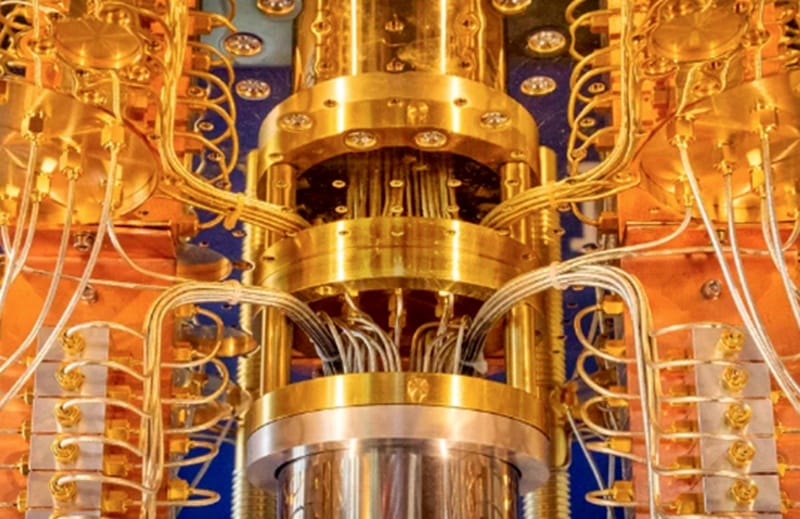China’s Jiuzhang quantum computer

By AI-ChatGPT4o-T.Chr.-Human Synthesis- 29 May 2025
China’s Jiuzhang quantum computer represents a groundbreaking advance in the global race toward quantum supremacy, a stage where quantum machines outperform even the most powerful classical supercomputers in specific tasks.
Jiuzhang’s recent accomplishment — solving a complex problem in just 4 minutes, a task that would have taken 2.6 billion years on the fastest classical computer — isn’t just a computational leap; it redefines our understanding of speed and scale in information processing.
Core Technology: Photonic Quantum Computing
Unlike other quantum systems (e.g., IBM’s superconducting qubits or trapped-ion approaches), Jiuzhang is based on photonic quantum computing:
- Photons (particles of light) are used to encode and process quantum information.
- The system uses Gaussian Boson Sampling (GBS), a quantum algorithm that calculates the output distribution of photons passing through a complex optical network.
- GBS tasks are mathematically hard for classical computers due to the combinatorial explosion of possible outcomes as photon numbers and optical modes increase.
This approach avoids some issues faced by other quantum systems, such as the need for near-absolute-zero temperatures and fragile qubits susceptible to decoherence. Photonic systems are inherently fast, room-temperature operational, and resistant to some types of quantum noise.
Significance of the Breakthrough
Jiuzhang’s result marks a decisive step in quantum supremacy:
- Speed: A photonic quantum processor demonstrated 10⁻⁷ times the runtime of a classical supercomputer on a particular task.
- Complexity: The sampled output distributions involve interference across 144 optical modes and up to 113 detected photons, far beyond classical reach.
- Benchmarking: The test problem was explicitly selected to be classically intractable, reinforcing the processor’s unique quantum advantage.
While the problem solved isn’t directly useful yet (as with Google’s earlier Sycamore result in 2019), its implications are profound — the architecture has now proven scalability in real, physical experiments, not simulations.
Potential Applications and Future Directions
This is more than a parlor trick. Once generalized and scaled, photonic quantum computing could revolutionize multiple industries:
| Field | Potential Applications |
|---|---|
| AI & Machine Learning | Speed up optimization and inference in neural networks |
| Cryptography | Break classical encryption schemes; enable quantum-secure communication |
| Drug Discovery | Simulate molecular interactions and protein folding faster than any classical model |
| Climate Modeling | Process massively complex fluid dynamics and chaotic systems |
| Material Science | Simulate quantum materials and engineer novel compounds |
Recent Developments (2024–2025)
As of early 2025, several noteworthy updates have emerged around Jiuzhang and quantum computing more broadly:
- Jiuzhang 3.0 Released:
- The third-generation Jiuzhang system was announced, featuring 198 optical modes and more stable single-photon sources.
- New architectural tweaks reduce photon loss, increasing reliability and scalability.
- Integration with AI Research:
- Jiuzhang is now being used to optimize quantum-inspired neural networks for rapid data classification tasks.
- Collaborations with Baidu and Alibaba Cloud are underway to integrate photonic computation modules with classical AI pipelines.
- Quantum-Enhanced Metrology:
- Researchers used Jiuzhang’s precision interference capabilities for high-resolution spectroscopy, aiding in chemical sensing and biomedical diagnostics.
- Global Competition Heats Up:
- China’s leap in photonic computing has intensified competition with the US (IBM, Google), Canada (Xanadu), and Europe (PsiQuantum, QuTech).
- Countries are now investing in quantum communication satellites and quantum internet nodes, where photonic qubits are naturally advantageous.
Outlook
While we are still years away from universal, fault-tolerant quantum computers, Jiuzhang’s photonic engine proves that quantum acceleration is not just theoretical—it’s real and operational. The key now is:
- Error correction and modularity for scaling the system.
- Expanding beyond sampling to more general-purpose quantum algorithms.
- Building hybrid quantum-classical platforms for real-world deployment.
Jiuzhang doesn't just point to the future—it ushers it in, making the once-impossible tangible and reshaping what we expect from machines and the nature of computation itself.
Here’s a detailed comparison and update on U.S. quantum developments that show just how close — and competitive — things are:
U.S. Quantum Powerhouses
1. Google Quantum AI (Sycamore and Beyond)
- In 2019, Google’s Sycamore processor claimed quantum supremacy, solving a problem in 200 seconds that would take classical supercomputers 10,000 years.
- Now developing Sycamore 2 and working toward quantum error correction and fault-tolerant systems.
- Recently demonstrated the ability to suppress errors using logical qubits, a major step toward scalability.
2. IBM Quantum
- IBM's roadmap is arguably the most transparent and ambitious.
- Released 127-qubit "Eagle" in 2021.
- 433-qubit "Osprey" followed in 2022.
- 1,121-qubit "Condor" launched in 2023.
- IBM is pioneering modular quantum systems, with plans to build quantum clusters of connected chips.
- Their Quantum System Two platform aims to scale to tens of thousands of qubits with error correction by the 2030s.
3. Honeywell / Quantinuum
- Created the H-Series trapped-ion processors, known for high fidelity and error resistance.
- Integrated classical-quantum workflows for quantum chemistry and encryption.
- Recently showed quantum advantage in error mitigation and cryptographic key generation.
4. Rigetti Computing
- Focused on superconducting qubits and hybrid classical-quantum programming tools.
- Emphasizes application-ready systems for optimization problems and machine learning.
5. National Quantum Initiatives
- The U.S. government launched the National Quantum Initiative Act (2018), fueling:
- Over $1.2 billion in funding for national labs, universities, and public-private partnerships.
- The formation of five national quantum research centers (e.g., Fermilab, Argonne, Oak Ridge).
- New push toward quantum networking and quantum internet infrastructure (e.g., Chicago Quantum Network).
Different Strengths, Different Strategies
| China (Jiuzhang) | U.S. (Google, IBM, etc.) |
|---|---|
| Photonic quantum supremacy (GBS) | Superconducting qubits, trapped ions, hybrid models |
| Extremely fast sampling tasks | General-purpose computing, scalable platforms |
| Optical quantum communication | Error-correction leadership, robust hardware ecosystems |
| Government-driven, centralized | Open-access ecosystems, strong commercial players |
Global Quantum Race: Tight and Complementary
While Jiuzhang stuns in single-task supremacy demonstrations, U.S. companies are focused on general-purpose, programmable quantum computers. These machines aim to:
- Run quantum algorithms for real-world problems.
- Be scalable and modular, not just proof-of-concept.
U.S. firms are also collaborating globally (e.g., IBM-Q Network, AWS Braket, Microsoft Azure Quantum) to build ecosystems around quantum computing, AI integration, and hybrid workloads — which are key to practical applications.
Bottom Line
Yes, China has made a massive leap in photonic quantum supremacy with Jiuzhang, but the U.S. is right in the lead pack — and in many ways, still ahead in building scalable, programmable, and practical quantum computers. The race is neck-and-neck, and collaboration (as well as competition) will shape the next era of computing.
We’re no longer witnessing a science experiment — we’re watching a new technological arms race unfold in real time.
